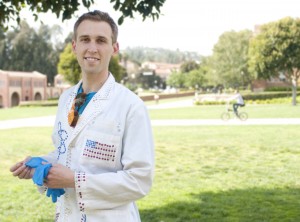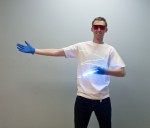A dancer in a sequined white lab coat shot smoke rings out of a machine, exploded hydrogen balloons and made his gloves glow in the dark.
As he moved to the beat of an upbeat hip-hop track, he mixed colorful chemicals in glass beakers, captivating the attention of the young audience.

“The older I got, the more I realized people weren’t into science,” Vinokur said. “I’m super passionate about it and I think it’s contagious. I have ‘mad scientist syndrome’ and I want to infect everyone.”
Vinokur said his journey to becoming who he is now was a long process fueled by his love of science.
Vinokur grew up in New Jersey. He spent his childhood running around his neighborhood’s backyards catching insects, inadvertently killing plants and mixing substances in his kitchen. His teachers did many science demonstrations during class, he said.
“Whenever they said, ‘Don’t try this at home,’ I couldn’t help but try,” Vinokur said, with a laugh.
During high school he worked in a hardware store, where he got materials for the makeshift laboratory in his garage, fully equipped with gas masks and long gloves.
Vinokur began participating in research when he was 16 years old, through a summer program at Rutgers University, where he studied sea monkey DNA. Throughout the school year and during summers, he worked in different labs to study photosynthesis and do bioenergy research.
Dancing became an important part of Vinokur’s life during his senior year of high school, when his parents went through a divorce. He began to secretly use dance as a distraction and way to express himself.
After six months of extensive dance practice with video tutorials, he began documenting his dance progress on YouTube and sending his videos around the dance community to get feedback and encouragement – even catching the attention of a scout from the television show “America’s Got Talent,” which he auditioned for but didn’t get on.
The idea of combining dance and science into an educational show like “The Dancing Scientist” came in 2010, from a chance encounter with a middle school program coordinator he sat next to on an airplane.
“I really like meeting people on airplanes, so as I was telling him my life story, he suggested that combining my passion for both of these things would be a really cool idea for an educational show,” Vinokur said.
At the time, Vinokur was studying biochemistry at the University of Wisconsin-Madison. He knew a professor who wrote books about science demonstrations and later agreed to help him assemble a show.
Vinokur emailed the same scout from “America’s Got Talent” and was invited back to audition as “The Dancing Scientist.” Although he did not make it past the top 100 acts in Las Vegas, he said he was determined to turn his 90-second audition into a full show and go on tour anyway.
Vinokur contacted several science research companies asking for sponsorships. FOTODYNE Inc., which is a science product manufacturing company, agreed and allowed him to contact schools all over the country to perform 45-minute shows called “So You Think You Can Do Science.”
He has done more than 120 shows so far.
Vinokur said he thinks his shows are popular because it gives kids a new perspective on science.
“People stereotype scientists as these weird old guys and kids think that’s what being a scientist looks like,” Vinokur said. “I don’t think that’s fair.”
He said he believes he has 45 minutes to make an impression and spark curiosity in kids that will make them want to learn more.
Vinokur now works with the agency Academic Entertainment, which helps him book shows at elementary and middle schools.
Gina Jamison, the director of Academic Entertainment, said the agency agreed to work with him because he is unlike anyone else they had ever seen.
“Not only is he highly credible, but he’s young and can really relate to kids,” Jamison said. “When you watch him, you can really see that he’s smart and has so much energy.”
Vinokur said one of his favorite experiences was performing at a festival at the same time as Bill Nye the Science Guy in 2012. He was amazed that a lot of people decided to watch him instead of Nye.
“(Vinokur)’s up there showcasing his infectious personality, blowing things up and dancing,” said Ann Merchant, the deputy executive director of communications at The National Academy of Sciences, the organization that showcased Vinokur at its exhibit during the festival. “Kids often feel like science is a remote and dry activity, but he changes that for them. … (They) need a hook to get them interested in pursuing the subject and he’s that first hook for them.”
Vinokur has not been able to perform as frequently after starting his doctorate program at UCLA this school year.
He said he chose to study at UCLA because he was impressed by the number of faculty working on bioenergy research, a subject in which he is particularly interested.
Todd Yeates, a professor of chemistry and biochemistry, said Vinokur stood out as a doctoral candidate because the admissions committee had not seen someone with his experiences before.
“He has exceptionally good people skills, which definitely comes across when he’s explaining and communicating his ideas,” Yeates said.
Vinokur said he wants his primary focus at the moment to be improving himself as a scientist and student, and eventually expanding on his shows.
“In one short show, I can’t teach kids everything,” he said. “But my main goal is just to spark curiosity and give everyone the best opportunity to get hooked on science.”

This guy is legit. We need more scientists like that!